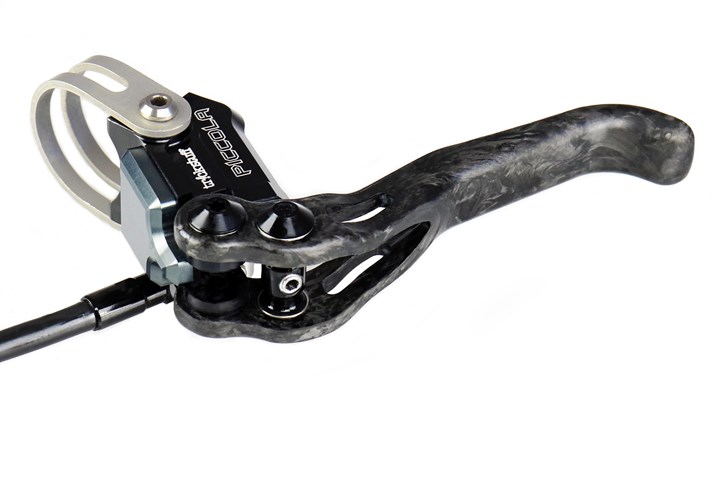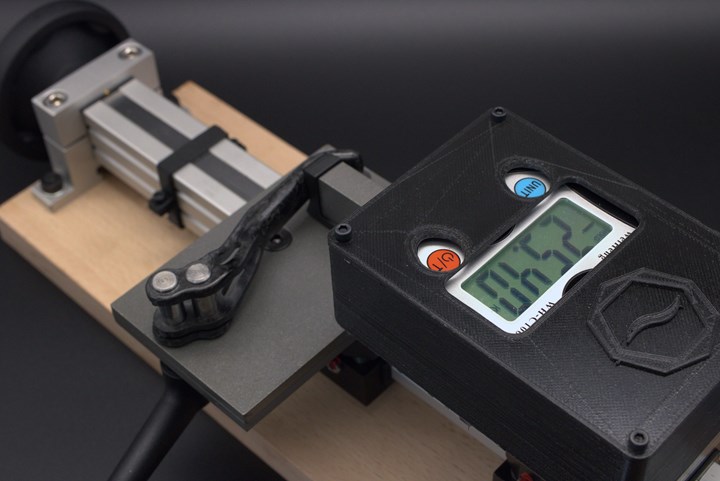
Premium composite brake levers designed by carbon fiber SMC specialist Blackwave are now available on Piccola series bicycles. Source, all images | Blackwave GmbH
“A carbon frame is almost standard on a good bike, but few people dare to build a carbon brake lever,” says Timon Strube, chief operating officer at (Taufkirchen, Germany). In partnership with bike part supplier (Freiburg, Germany), Blackwave recently designed a premium brake lever manufactured with carbon fiber sheet molding compound (SMC) that is said to save weight by 35% compared to the previous aluminum version.
Blackwave is fairly new to the sporting goods market, but not to carbon fiber SMC. The company was founded in 2016 by former college classmates Bastian Behrens, CEO, and Raphael Setz, chief technical officer, with a focus on specialty automotive components built from carbon fiber SMC. Behrens and Setz first met at the Technical University of Munich (TUM), where they successfully built carbon fiber SMC car rims for their school’s Formula Student vehicle design and engineering team. The vehicle, Behrens says, was highly successful in the collegiate competition, ranking third in the world in 2013. Those SMC rims would serve as inspiration for the partners’ new company.

Blackwave operates a series of Langzauner hydraulic presses, producing carbon fiber SMC parts out of its facility in Taufkirchen, Germany.
The next four years saw Blackwave expand into a larger facility in 2018, finish its first large-volume order for Porsche in 2019 and close a new seven-digit round of funding at the beginning of 2020. Now, according to Behrens, Blackwave is expanding its specialty services in small, complex carbon fiber SMC part fabrication into new markets such as sporting goods applications.
The brake lever project began in summer 2019, when Blackwave first met representatives from Trickstuff at the Riva Bike Festival in Riva del Garda, Italy. Trickstuff is said to be developing the lightest, strongest disc brake in the world — called the Piccola series — and approached Blackwave about developing a carbon fiber SMC brake lever as part of the project.
To design the part, Blackwave had to rethink the brake lever geometry to meet mechanical requirements using the new material. Finite element analysis (FEM) was used to identify highly stressed areas of the part, informing decisions about fiber orientation in different parts of the lever. After a few iterations and additional testing, the final part features a mostly unidirectional (UD) fiber orientation for the tension and compression strut, with a circular fiber orientation around the bearing set. According to Blackwave, the new brake lever, weighing in at 7 grams, falls into the lightweight range and can also withstand a lever force of at least 300 Newtons.
To build the brake lever, Blackwave cuts the Astar (Sondika, Spain) carbon fiber SMC material to the correct shape using a CNC cutting machine. The preforms are inserted and molded using a (Lambrechten, Austria) hydraulic press system. Once ejected, the parts are trimmed and milled using (Bobingen, Germany) milling bits/equipment. In the final steps, the maximum force is tested and the surface gets finished.

Blackwave tests parts in-house to make sure they meet force requirements.
“We're doing everything from concept up to ready-to-assemble parts. This is necessary, because most of our customers have never even heard about carbon-SMC. So we take our customers by the hand from the very beginning,” Behrens says.
After successful endurance and maximum force testing of the brake levers last winter, Blackwave began series production of the parts, and today, every disc brake of the Piccola series is delivered with a composite brake lever.
According to Behrens, Blackwave continues to expand its business into other sporting goods applications, as well as complex parts for the space, aviation and medical industries. The company also reports that it has recently launched its largest series so far, consisting of 30,000 components for the automotive industry.
Related Content
Bcomp, Siux bring natural fiber composites to padel tennis
Flax fibers enter the court through Siux’s GEA padel racquets, delivering high-performance, well-balance sports equipment to a rapidly growing sports market.
Read MoreCompPair healable composites, recycled carbon fibers featured in ID Genève luxury watch
HealTech prepregs enable 400x faster regenerative properties for the new Circular C product, along with incorporation of industrial waste fibers for a sustainable touch.
Read MoreCarbon Mobile carbon fiber powers handheld gaming platform
HyRECM technology effectively stabilizes carbon fiber’s electrical and antenna properties, enabling development of next-gen electronics, such as the Snapdragon G3x Gen 2.
Read MoreComposites end markets: Electronics (2025)
Electronic and smart device innovations achieved through the use of advanced materials ranging from thermoplastic composites to biomaterials emphasize high-volume production and sustainability.
Read MoreRead Next
Cutting 100 pounds, certification time for the X-59 nose cone
Swift Engineering used HyperX software to remove 100 pounds from 38-foot graphite/epoxy cored nose cone for X-59 supersonic aircraft.
Read MoreNext-gen fan blades: Hybrid twin RTM, printed sensors, laser shock disassembly
MORPHO project demonstrates blade with 20% faster RTM cure cycle, uses AI-based monitoring for improved maintenance/life cycle management and proves laser shock disassembly for recycling.
Read MoreCeramic matrix composites: Faster, cheaper, higher temperature
New players proliferate, increasing CMC materials and manufacturing capacity, novel processes and automation to meet demand for higher part volumes and performance.
Read More
.jpg;width=70;height=70;mode=crop)












